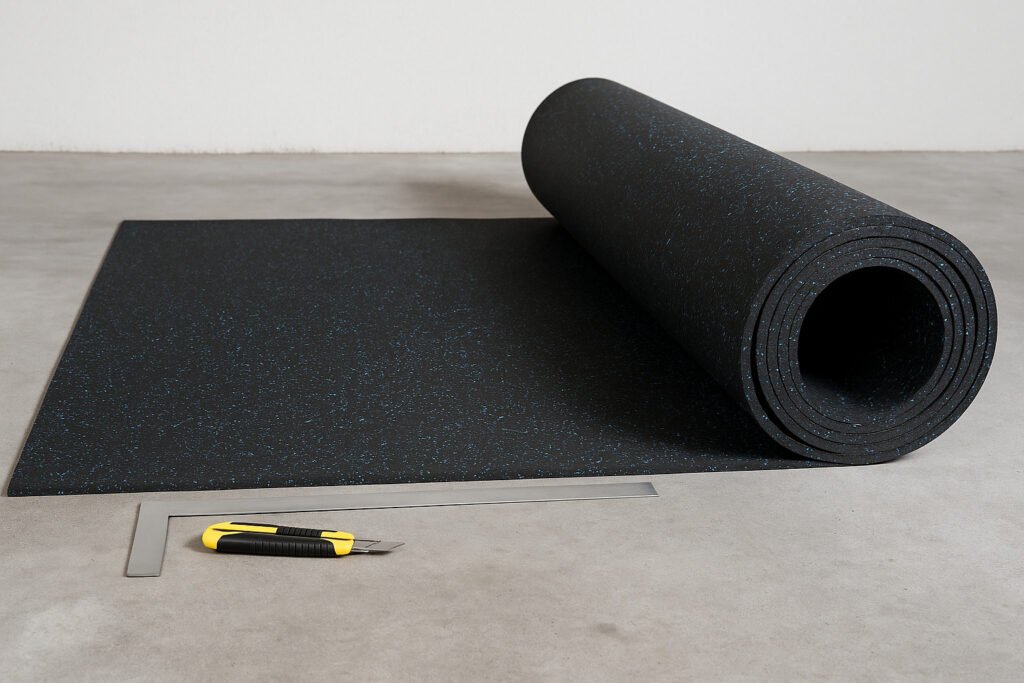Gym Rubber Roll Installation Problems and Solutions – Complete Guide
Gym rubber rolls are popular for large seamless coverage in fitness centers. But poor installation often leads to curling edges, bubbles, and seam gaps.
The most common problems during gym rubber roll installation include curling edges, seam gaps, bubbles, shifting, slippery surfaces, wear, fading, and odor. Each issue has practical solutions.

Many gym owners and contractors ask us: “Why do rubber rolls curl, and how can I fix them?” This guide answers those questions step by step.
Why Do Curling Edges Happen?
Curling edges are the number one complaint with gym rubber rolls.
They are caused by uneven subfloors, weak adhesive, or no expansion gap.

Dive Deeper
- Causes: dust or bumps on subfloor, adhesive spread too thin, no expansion gap left at walls.
- Solutions: re-press edges with roller, re-glue lifted areas, use heat gun for flattening, always leave 2–5mm gap.
👉 This is why many people search “how to fix curling rubber roll edges in gym installation.”
Table: Curling Edges
| Cause | Impact | Solution |
|---|---|---|
| Uneven subfloor | Edges won’t stay flat | Clean and level surface |
| Weak adhesive | Corners peel up | Use full glue coverage |
| No expansion gap | Buckling in hot rooms | Leave 2–5mm around walls |
Why Do Seams Crack or Open?
Seam gaps make the floor look poor and trap dirt and sweat.
They happen when rolls are cut badly or not glued enough at seams.
Dive Deeper
- Use sharp knife and straight ruler for clean cuts.
- Apply adhesive fully across seam edges.
- Seal with seam tape to block dirt.
👉 Many clients search “rubber roll seams opening problem in gym.”
Table: Seam Gaps
| Cause | Impact | Solution |
|---|---|---|
| Bad cutting | Uneven visible gaps | Cut straight with ruler |
| Weak adhesive | Seams lift | Apply seam adhesive |
| No seal | Dirt collects | Use seam sealing tape |
Why Do Bubbles or Air Pockets Form?
Bubbles make floors uneven and unsafe.
They are caused by trapped air or damp subfloors.
Dive Deeper
- Always dry subfloor before installation.
- Press rolls firmly with a heavy roller.
- If bubbles appear, puncture gently and re-glue.
👉 This matches searches like “how to fix bubbles under rubber flooring.”
Why Do Rolls Shift or Slide?
Shifting creates dangerous gaps during workouts.
It happens when rolls are not fixed with glue or tape.
Dive Deeper
- For temporary gyms: use strong double-sided tape.
- For commercial gyms: full glue-down is always best.
👉 People often search “rubber roll shifting during gym use.”
Why Do Floors Get Slippery?
Slippery floors increase accident risks.
Sweat, spills, or poor surface texture make rubber rolls slippery.
Dive Deeper
- Choose rolls with anti-slip surface.
- Clean sweat and water immediately.
- Improve gym ventilation.
Why Do Rolls Wear or Fade?
Wear and fading happen in weightlifting or cardio zones with heavy traffic.
Low-quality rolls or long use cause faster damage.
Dive Deeper
- Use EPDM or composite rolls for better durability (see product here).
- Rotate machines to balance pressure.
- Replace only damaged sections if possible.
Why Does Rubber Roll Smell?
New installations often release rubber odor.
The smell comes from rubber materials, especially if ventilation is poor.
Dive Deeper
- Choose EN1177/CE certified eco rolls (learn more).
- Ventilate the gym after installation.
- Mop with warm water and mild cleaner.
FAQ
How to fix curling edges on rubber rolls?
→ Re-glue, heat press, and leave expansion gaps.Do rubber rolls always need glue?
→ Yes for heavy-use gyms; tape is enough for small spaces.How to prevent seam gaps?
→ Cut straight, apply adhesive fully, and seal seams.Can bubbles be repaired?
→ Yes, puncture carefully, press flat, and re-glue.How thick should gym rubber rolls be?
→ 6–12mm for cardio/yoga zones; 20–50mm tiles for weightlifting.Can rubber rolls be replaced individually?
→ Yes, damaged rolls can be cut and replaced.Are rubber rolls slippery when wet?
→ Yes, so always clean spills quickly.How long do rubber rolls last in gyms?
→ Around 5–8 years depending on quality and use.Rubber rolls vs rubber tiles – which is better for gyms?
→ Rolls are best for cardio and large areas; tiles are best for weight zones.Why do new rolls smell strongly?
→ Odor comes from rubber; it fades with ventilation and cleaning.
Related Blogs
- How to Install Rubber Flooring on Concrete
- 10 Tips for Installing Rubber Flooring
- Rubber Roll Installation Mistakes
- Best Material for Gym Flooring
- Why Do Gyms Use Rubber Flooring?
Conclusion
Most gym rubber roll issues come from poor installation. By preparing subfloors, using proper adhesive, and maintaining rolls well, gyms ensure long-lasting and safe flooring.
